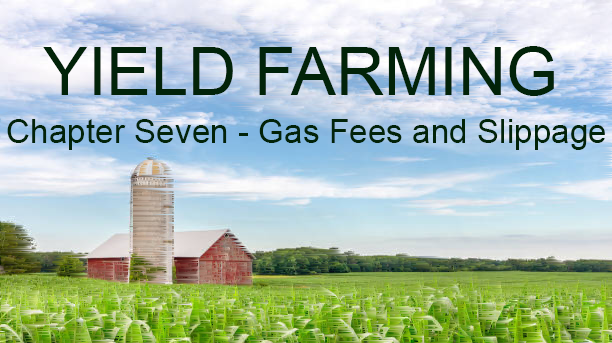Yield Farming Chapter Seven - Gas Fees, Slippage and Other Fees

This is Chapter Seven, focused on Gas Fees and Slippage, in a series of articles that will be released about yield farming. The purpose of this series is to introduce the concept of yield farming to those who are unfamiliar with it, then move into various yield farming strategies and finally step-by-step walkthrough of the process. I hope you enjoy the series and any feedback you have would be greatly appreciated.
Chapter Seven - Gas Fees, Slippage and Taxes
Gas = a substance or matter in a state in which it will expand freely to fill the whole of a container
Fees = a payment made to a professional person or to a professional or public body in exchange for advice or services
Slippage = the action or process of something slipping or subsiding
There are a number of costs associated with yield farming including both gas fees and slippage. It is important to know what each of these fees are as they will impact your overall returns. These fees can apply to various transactions within cryptocurrency and not just yield farming.
Gas Fees
A gas fee is the amount you need to pay to perform a transaction on a network. These fees are typically priced in small amounts of the main coin or token used on the network. For example, on the Ethereum network it will cost a fraction of Ethereum (ETH) to perform a transaction or execute a contract. These fractions of Ethereum are denoted in terms of a "gwei" when estimated and eventually paid.
Gas fees are used to pay miners for their work in verifying transactions and securing a network. It is the miners who set the gas fees on a network like Ethereum that is Proof of Work. If the gas fee is too low, miners can choose to ignore the transaction.
It is important to note that different networks charge different gas fees. Ethereum is one of, if not the most expensive network to conduct transactions on which is one of the reasons so many competing networks have emerged. These so-called "Ethereum Killers" perform the same transactions for significantly lower gas fees and usually at much faster speeds.
If you plan to yield farm with smaller amounts of capital, it may be wise to choose a farm on a non-Ethereum network so your transactions will not eat into your profits.
Slippage
Slippage is the difference in price of an asset you expect to pay and what you actually pay. Slippage is determined by two factors, liquidity and volatility. While the term slippage generally is seen as negative, it is noteworthy that slippage can also be positive and work in your favor as well as you can receive a better price than originally expected.
Liquidity is critical because the more liquidity an asset has the easier it is to convert to cash or another asset. The less liquid an asset is, the less backing it has to trade and the bigger the impact of a high volume trade. Imagine a token that has $100,000 in liquidity and someone wants to sell $80,000 worth of that token - what do you think will happen to the price? It will drop significantly. Now imagine the same token sale transaction where there is $100M in liquidity, the sale will have almost no impact on price.
Volatility is the other important factor when it comes to slippage. The more volatile the token, the more the price swings wildly. As you are trying to make a transaction on that coin, the more the price is changing as you are performing the transaction requiring a higher slippage to account for those price changes.
Slippage Calculation
Slippage in cryptocurrency is generally expressed in percentage terms but it can also be expressed in monetary terms as well such as dollar amounts.
$ of slippage / (LOP - EP) x 100 = % slippage
EP = expected price
LOP = limit order price / worst expected price
When purchasing any cryptocurrency you can use a market order which simply buys the token as quickly as possible at the current price or place a limit order. You are more vulnerable to slippage with a market order because when you place a limit order you reduce the slippage on the high end by putting a limit on the price you are willing to pay for the token.
Other Fees
Many platforms will place charges on both buy and sell transactions within their platform. These are almost always expressed in percentage terms and are often different between buy and sell transactions. These can be rather large fees and it is important to understand the fees on both the buy and sell side to calculate your returns.
These fees are used to pay the developers, go towards marketing the platform to new users, build liquidity within a platform's treasury, burn (or get rid of) tokens to cause upward price action, or they can be used as rewards to existing holders of the tokens.
Whiteboard Crypto YouTube Video - What is Ethereum Gas?
Previous Chapters
Yield Farming Chapter One - What is Yield Farming?
Yield Farming Chapter Two - Decentralized Finance
Yield Farming Chapter Three - Automated Market Maker
Yield Farming Chapter Four - Liquidity Pools